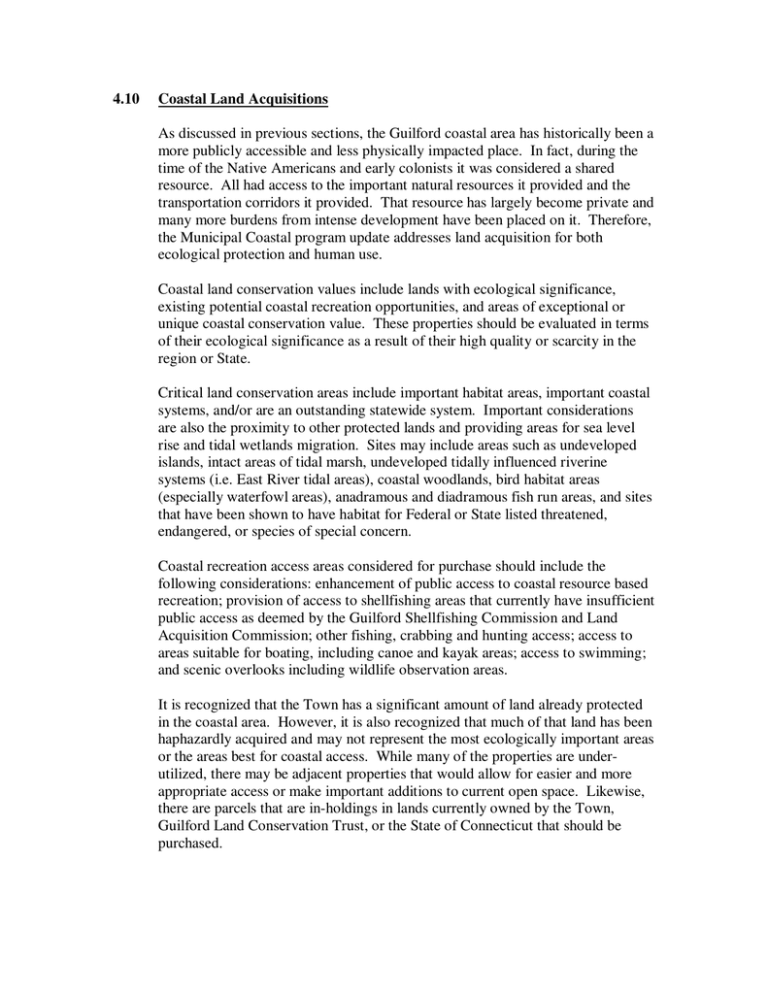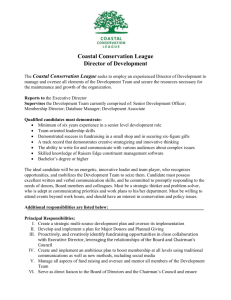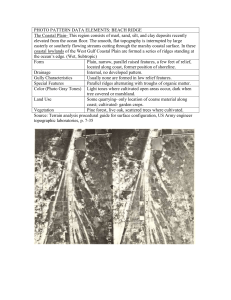4.10 Coastal Land Acquisitions As discussed in previous sections
advertisement

4.10 Coastal Land Acquisitions As discussed in previous sections, the Guilford coastal area has historically been a more publicly accessible and less physically impacted place. In fact, during the time of the Native Americans and early colonists it was considered a shared resource. All had access to the important natural resources it provided and the transportation corridors it provided. That resource has largely become private and many more burdens from intense development have been placed on it. Therefore, the Municipal Coastal program update addresses land acquisition for both ecological protection and human use. Coastal land conservation values include lands with ecological significance, existing potential coastal recreation opportunities, and areas of exceptional or unique coastal conservation value. These properties should be evaluated in terms of their ecological significance as a result of their high quality or scarcity in the region or State. Critical land conservation areas include important habitat areas, important coastal systems, and/or are an outstanding statewide system. Important considerations are also the proximity to other protected lands and providing areas for sea level rise and tidal wetlands migration. Sites may include areas such as undeveloped islands, intact areas of tidal marsh, undeveloped tidally influenced riverine systems (i.e. East River tidal areas), coastal woodlands, bird habitat areas (especially waterfowl areas), anadramous and diadramous fish run areas, and sites that have been shown to have habitat for Federal or State listed threatened, endangered, or species of special concern. Coastal recreation access areas considered for purchase should include the following considerations: enhancement of public access to coastal resource based recreation; provision of access to shellfishing areas that currently have insufficient public access as deemed by the Guilford Shellfishing Commission and Land Acquisition Commission; other fishing, crabbing and hunting access; access to areas suitable for boating, including canoe and kayak areas; access to swimming; and scenic overlooks including wildlife observation areas. It is recognized that the Town has a significant amount of land already protected in the coastal area. However, it is also recognized that much of that land has been haphazardly acquired and may not represent the most ecologically important areas or the areas best for coastal access. While many of the properties are underutilized, there may be adjacent properties that would allow for easier and more appropriate access or make important additions to current open space. Likewise, there are parcels that are in-holdings in lands currently owned by the Town, Guilford Land Conservation Trust, or the State of Connecticut that should be purchased. Recommendations for open space acquisitions in the coastal management area were received from members of the public, neighborhood associations, the Audubon Society, the Guilford Land Conservation Trust, the Guilford Preservation Alliance, and the Committee to Save the Guilford Shoreline. In addition, the following were reviewed: Draft Connecticut Coastal and Estuarine Land Conservation Program Plan (October 2007) State Plan of Conservation & Development (2005-2010) Natural Resource Inventory and Assessment (January 2005) Plan for Open Space and Municipal Land Needs developed by the Guilford Land Acquisition Committee. These resources provide a framework for prioritizing coastal land acquisitions. These acquisitions should continue with appropriate consideration given to the reasons for each acquisition.




